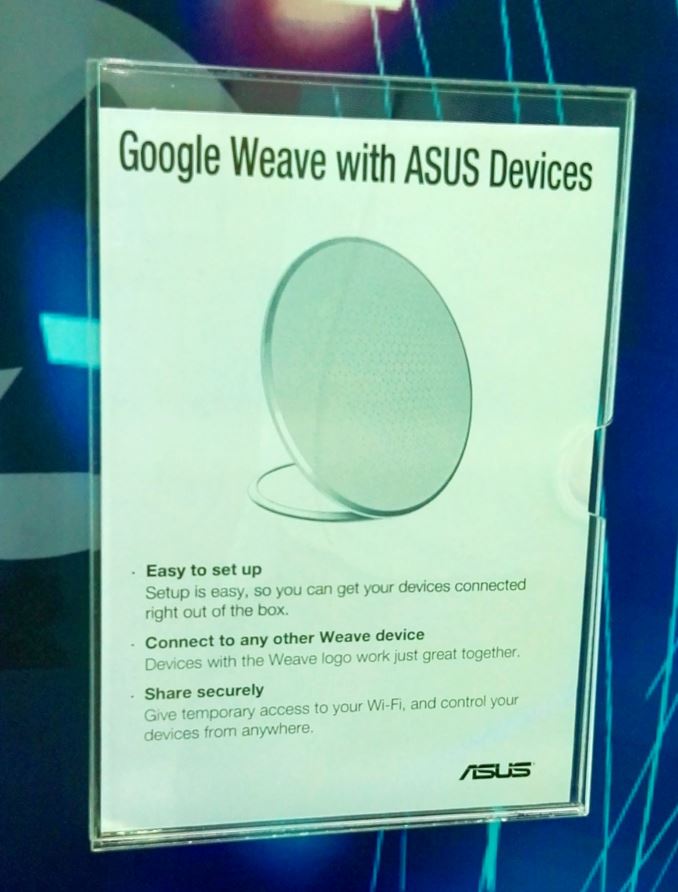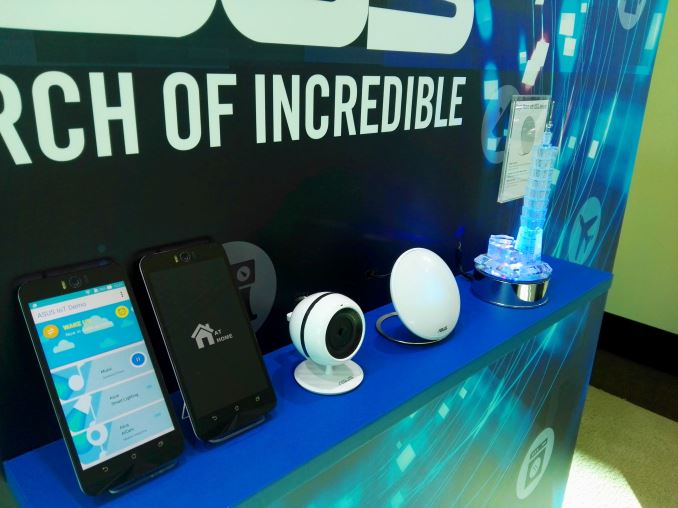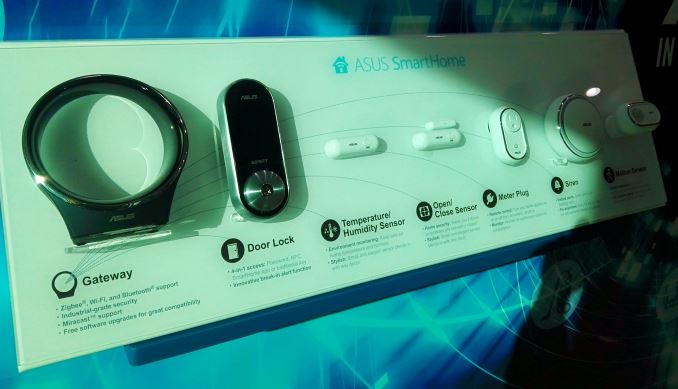ASUS Booth Tour at CES 2016: 10G Switches, External GPU Dock, USB-C Monitor and more
by Ian Cutress on January 19, 2016 9:00 AM ESTIn the last couple of years, every show we have attended affords the same questions on the Internet of Things: where do we see it going, when is it going to take off, what volume should be expect and what form factor will it arrive? You may have noticed that AnandTech has been relatively light on IoT coverage, perhaps for good reason: there’s an awful lot of awful hardware moving around at low cost, with most of it still in that beta stage of anything.
When the Internet of Things Becomes Useful
For me (Ian) personally, IoT has to satisfy two crucial categories: it has to be able to improve my daily flow of things, and it has to seamlessly work together. At the minute, most IoT fails to do either, especially with sportswear that merely tells you about what you have done. I don’t necessarily want to know what I have done (yes, I get the big data and improve angle), I want to be able to get things done quicker with the equipment at hand. Something as simple as being able to preopen a Chrome window at the webpage I need on my PC while I’m in the kitchen washing up so that it is there when I get to the computer. Or something that will tell me if the fridge/freezer door has been left open for more than five minutes again. Or a series of power monitoring outlets that I can access from a central application to see where my energy provider is clearly picking numbers out of thin air from. Or I can preload the next few music tracks/videos in my stream when I’m in another part of the house so that when I get there, it isn’t buffering the content or the advertisements for the first fifteen seconds. Does that sound like too much?
As we take baby steps into the future, ASUS is playing on the Google Weave project. Weave is designed to be the standardized API glue that binds products with Weave certification to be able to communicate with each other, the cloud, and the devices a user owns. As noted above, the design is meant for intra-comms within a network and internet communication over the web.
Over the next few years, as ASUS feels its way into the IoT space, I was told that Weave will be one of the standards they will keep close to, especially when it comes to hardware and software.
ASUS for the most part already offers a number of ‘SmartHome’ products, as shown above, and the assumption is that many of these down the line will fit into that Weave mold. My contention is that there are two very distinct levels of IoT product: ones that are designed to be binary (power switch is on/off), or ones that are designed to provide feedback (power switch that gives you a reading). It is the feedback devices that need to be configured so users can interpret the data. For example, if I have several power switches that can read power consumption, I want to be able to view how all of them are doing and perhaps record that data. If the software only allows me to connect with one at a time, or only view one at a time, that leaves it in the hands of the crowd that only wants binary operation. Ultimately I would argue it is the non-binary crowd who will be the early adopters. Same thing for smart locks, or temperature sensors – if I have several smart locks around the house, I want to know the status of each one, and perhaps I want push notifications when one is used (or abused).
I always say a lot of IoT devices have potential, the issue for me is always going to be utility, configuration, ease of use and software. Though the obvious prediction for now is that there will be several standards that won’t interoperate and a user will have to invest into a certain ecosystem to get the best benefit. That kind of sounds like the smartphone Android vs iOS debate all over again. Fingers crossed it runs a bit smoother for IoT.













50 Comments
View All Comments
randomhkkid - Tuesday, January 19, 2016 - link
The ROG GX700 dock only contains radiators and pumps, the 980 laptop gpu is housed in the laptop itself. http://core0.staticworld.net/images/article/2015/1...hechacker1 - Tuesday, January 19, 2016 - link
That's a good start for a 10G switch, but it really needs more 10G ports to be useful. I deploy 10G all the time for my job, and we use the Intel X520, which is a generation behind, but stable as a rock and supported everywhere. It also can be found for relatively cheap (sometimes $250). At those prices it almost makes sense to build your own "switch" by just using 10G cards and directly connecting where you need it. I know in my environment I really only need 10G to my NAS, and then 10G to the workstation for media / VMs.BrokenCrayons - Tuesday, January 19, 2016 - link
A Cherry Trail phone with 4GB of RAM and 256GB of storage for $350 sounds great. Now if only a certain software company that makes operating systems would be kind enough to stop it with the silly pricing that keeps budget laptops with Cherry Trail processors chained to half that much RAM and 1/8th of the storage. >.<Pissedoffyouth - Tuesday, January 19, 2016 - link
Why the hell do they have to make a retarded version of the zenphone with bigger battery. Give me the atom version with 5000mah battery and I'll pay good money for itcfineman - Tuesday, January 19, 2016 - link
So when is that gsync monitor coming out? Seems like's it's been vaporware for a while... are they trying to work out the of the QC issues Acer has been dealing with or...???CaedenV - Wednesday, January 20, 2016 - link
@Ian, I am also excited that 10/t is finally coming to the consumer market! I have a NAS, and constantly have to move around ISOs and uncompressed video files/projects between my main PC and my NAS. Thankfully I get a solid 98-102MB/s... but the idea of being able to get 980MB-1GB/s sounds too good to be true! I mean, a Windows ISO would take a mere 10 secconds to transfer... heck at those speeds just use the NAS like a local HDD and write straight to and from it without ever transferring to a local disc!Thankfully for me though, the rest of my family is quite alright with gigabit Ethernet and WiFi, so having only 2 10Gb/s connections is not a bad limitation for me. They need to bring the price down a bit more before I'll bite though. $200 for an unmanaged switch with 2 10Gb/s ports and 4 1Gb/s ports, and $75-100 for each card. Still, I could see it being something when I do my next big build in a few short years.
... now if only they can do something about my 25mbps internet conneciton and 5mbps uplink...
sor - Wednesday, January 20, 2016 - link
The switches are underwhelming. We've had affordable switches with a few 10g + a bunch of 1g for awhile.10g baseT has been a pretty epic failure so far. I managed to find a 48 port Dell 3 years ago, pretty much the only full 10G baseT available, and it was so power hungry that it couldn't keep more than 24 ports running at once. They took it back, then discontinued the line. SFP+ and twinax for cheap copper interconnects worked much better.
merikafyeah - Wednesday, January 20, 2016 - link
10GbaseT is actually a mandatory part of the Thunderbolt 3 spec, so a TB3 (USB Type-C) switch could finally bring affordable 1GB+/s transfers to consumers.noeldillabough - Wednesday, January 20, 2016 - link
Will 10G work reliably over Cat6/6a? Or do we need to use Cat7/8 etc?sor - Thursday, January 21, 2016 - link
6a is the standard for 10g baseT. There are other types floating around like 6e, 7, 7a, etc, but none are standards based, mostly marketing.